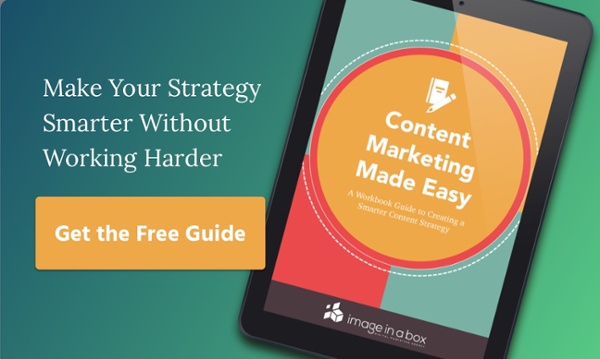The First Step in Strategic Content Planning

Contents
Content planning is more than just deciding on topics and scheduling posts. Before you start anything else, you must set short-term and long-term goals that you plan to achieve in your content strategy. This is an essential step when planning, and if it’s skipped, you won’t know how effective your content marketing is, which defeats the whole purpose of your efforts. We’ll discuss why and how you should set goals to create a strategic content plan.
Content Plan Goals
Content plan goals will hold you accountable, guide you through your planning, and will measure the success of your content marketing strategy.
Why You Should Set Goals
 To accurately measure the success of your content marketing efforts, you have to set goals. It’s important to make sure you have both short-term and long-term goals.
To accurately measure the success of your content marketing efforts, you have to set goals. It’s important to make sure you have both short-term and long-term goals.
If you just set long-term goals, they will seem so distant and you may become discouraged and veer away from your content plan. To avoid that, you need to set short-term goals. Not only will short-term goals keep you on track, but if your results aren’t what you were expecting, you can optimize and adjust your strategy. Short-term goals are smaller goals within a shorter time span that ultimately work towards your long-term goals.
How to Set SMART Goals
When setting your content plan short-term and long-term goals, you need to ensure they are SMART:
- Specific - Describe exact numbers, timeframes, platforms, etc.
- Measurable - Explain the exact results you’re expecting and when you are expecting to see them.
- Attainable - Make sure your goals are challenging but realistic.
- Relevant - Create goals that are relevant to your organization’s growth.
- Timely - Give yourself an adequate amount of time to see results.
Here are a couple of examples of short-term and long-term SMART goals that are paired together:
Audience Engagement Goal Example
Short-Term SMART Goal: A 25% increase in audience engagement on blog promotion Facebook posts by the end of the quarter.
- Specific: We specified the percentage increase, what social media platform, and what kind of posts we want users to engage with
- Measurable: By providing an exact percentage, we’ll know exactly how successful our efforts were
- Attainable: We chose a reasonable percentage goal in an attainable timeframe
- Relevant: Blog promotion and audience engagement are relevant pieces of a content marketing strategy
- Timely: 3 months is a good timeframe to collect accurate data and measure success
Long-Term SMART Goal: Increase the number of Facebook followers by 200 by the end of the year.
- Specific: We specified the social media platform, the number of followers, and the timeframe.
- Measurable: The number of followers is measurable and we will be able to calculate how close to the goal we are
- Attainable: If the short-term goal of a 25% increase in engagement is met, then an increased number of followers is attainable.
- Relevant: Audience engagement is a key factor to staying relevant to your buyer persona, so it works as a long-term goal in a content plan.
- Timely: Reviewing the goal after the year is long enough to see how effective the content plan was
The short-term goal in this example is engagement. Higher engagement on social media can be achieved quickly whether it’s through compelling copy targeted towards your audience or paid promotion. Make sure that your goals match your budget. For example, if you need to pay for social ads in order to meet your goal, be sure that your budget can help you get to the number you set.
Increased engagement on social media posts can lead to an increase in followers, which is why that is the long-term goal in this scenario. Building a following on social media that consists of your target audience can’t happen overnight. It’s a long process that can be achieved through increased engagement. If SMART short-term goals are set each quarter for increased engagement, then it is more likely that the long-term goal would be achieved.
Both of these goals can help during the content planning process because you will need to create compelling, relevant content to achieve these. Let’s take a look at another example.
Lead Generation Goal Example
Short-Term SMART Goal: Increase total blog visits by 15% each month for 12 months.
- Specific: We are specifying the type of traffic and the exact increase we want to see.
- Measurable: The timeframe and percentage allows us to come back and accurately measure the goal
- Attainable: By having a small percentage set each month, the goal is realistic.
- Relevant: Attracting your target audience to website content is a key part of a content marketing strategy
- Timely: We are checking in on the goal every month over the course of 12 months
Long-Term SMART Goal: Generate 5 additional leads per month from your blog posts in one year.
- Specific: We set an exact number of new leads, the generation source, and a timeframe
- Measurable: We will be able to measure how many new leads we generate from blogs each month over the course of one year.
- Attainable: We are aiming to generate at least 5 new leads per month which is attainable if our short-term goal of increased traffic stays on track
- Relevant: Generating new leads for your business is one of the main reasons to create content in the first place
- Timely: One year is a reasonable timeframe to see if the content is working to generate new leads
In this example, the short-term goal of traffic coincides with the long-term goal of lead generation. Increasing traffic is considered short-term in this scenario because we are looking at the data every month for one year and it helps facilitate the long-term goal.
Increasing leads will take time, which is why lead generation is a long-term goal. A steady increase in website traffic can lead to a growth in brand awareness, and more leads can be generated with proper CTA placement for relevant offers on compelling content.
The Next Step
After you set your goals, you can begin to create the rest of your content plan which will figure out how you are going to achieve your goals. Be sure to monitor your goals immediately through Google Analytics or HubSpot. Review all goals monthly, and adjust if necessary. Every quarter you should review and adjust your current goals and also create new ones.
How to Optimize Your Goals
If you are not trending towards your short-term goal by the halfway mark in your specified timeframe, then you need to analyze your data to optimize your goals. It could be that your goals weren’t attainable or that your content wasn’t compelling enough. Adjust your goals accordingly based on what your data reveals.
If you are hitting your short-term goals, but not trending towards long-term goals, then you should reevaluate the connection between your short-term and long-term goals and adjust them accordingly.
For example, if you are seeing an increase in blog traffic, but not in lead generation, then focus on adjusting your target audience or your content. It can be something as simple as optimizing the format and styling of your blog posts to something more involved like writing about new topics towards a different target audience. Also make sure that your content is easy to skim, organized, and has informative introductions.
When you’re ready to create a strategic content plan, setting SMART goals should be your first step so that you can refer back to them often to ensure you are making progress in your plan. They are a great way to hold you accountable and to look back and see accurate results of your content marketing efforts.
Need a place to plan out your SMART goals and the rest of your content strategy?
Check out our free workbook guide that walks you through each step of creating a smart content strategy, so that you don't have to work harder in the long run. Click below to learn more and download today!

